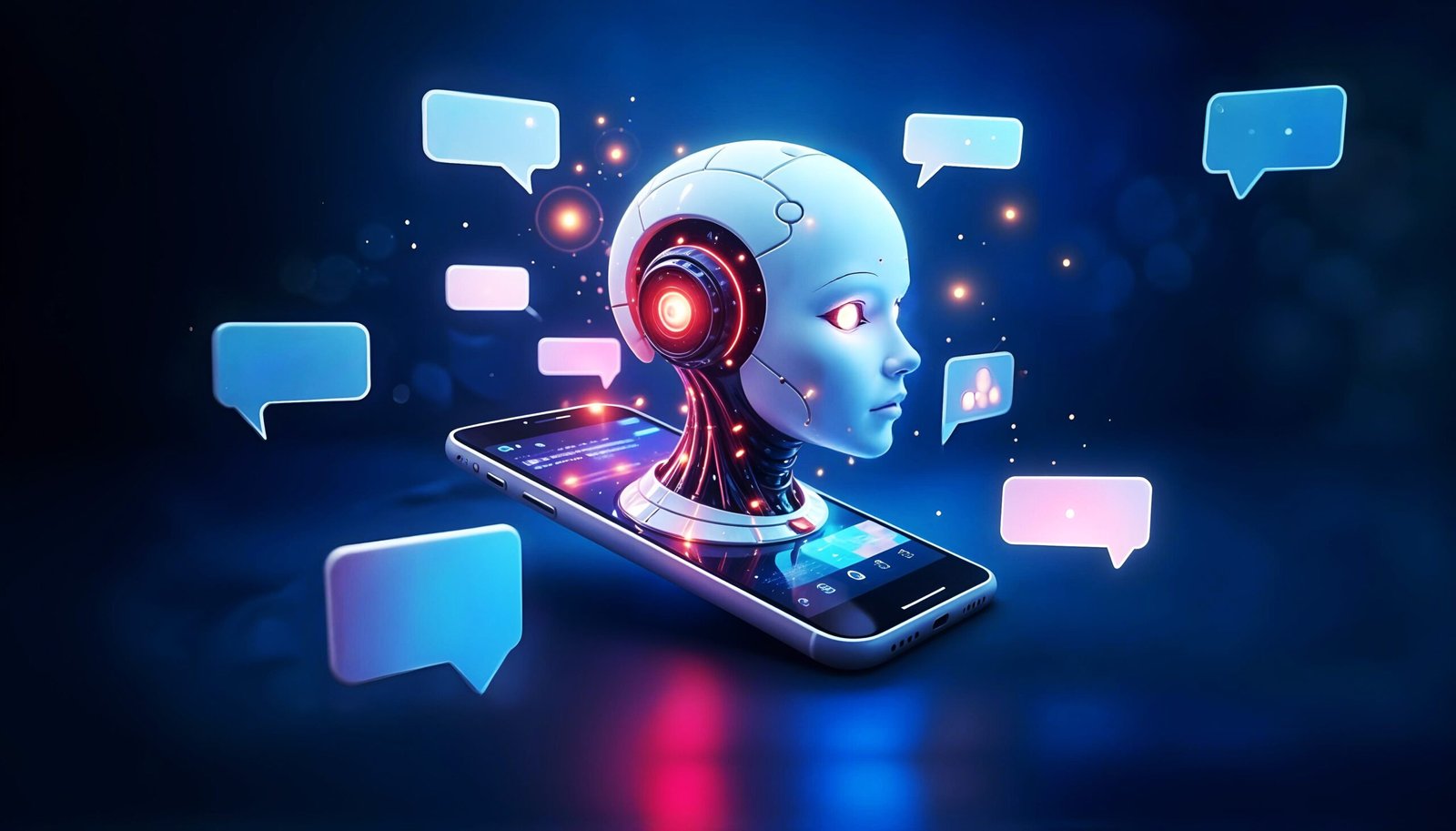Every day, millions of people across the globe reach into their pockets, pull out their smartphones, and tap into a universe of possibilities. Whether it’s snapping a photo, navigating traffic, chatting with friends, or shopping online, today’s smartphones feel almost magical. But behind that magic is a powerful, unseen force: artificial intelligence (AI).
AI is no longer a futuristic fantasy confined to sci-fi novels or sprawling tech laboratories. It’s already here, woven into the fabric of your daily digital experiences. Your smartphone is a powerhouse of AI innovation — a personal assistant, translator, photographer, and security guard, all in one device no bigger than your hand.
So how exactly does AI power your smartphone? Let’s take a fascinating deep dive into the many ways this invisible genius transforms your device into a smart, responsive, and personalized companion.
AI at the Heart of Modern Smartphones
To understand the depth of AI’s impact, it’s essential to know that AI in smartphones doesn’t just mean a few fancy features sprinkled on top. AI is deeply embedded at the hardware and software levels, orchestrating everything from how your device conserves battery life to how it predicts your next move.
At its core, smartphone AI can be divided into three broad categories:
- Machine Learning: Teaching the phone to recognize patterns and make predictions based on data.
- Natural Language Processing (NLP): Helping the phone understand and generate human language.
- Computer Vision: Enabling the phone to interpret and analyze visual information from the world.
These technologies work together seamlessly, creating the smooth, intuitive experiences users now expect as standard.
Personalized User Experience: Your Phone Knows You
Have you ever noticed how your smartphone seems to “know” what you want before you even ask? That’s AI working behind the scenes, crafting a personalized experience based on your behaviors, preferences, and interactions.
AI algorithms analyze your usage patterns — when you use your phone, which apps you prefer, even how you type — to anticipate your needs. Over time, your phone learns whether you’re a morning news reader, a night owl social media scroller, or an afternoon gamer.
Predictive suggestions are one of the most visible aspects of this personalization. Your smartphone might suggest apps you usually open at a certain time of day or predict the next word you’re going to type based on your previous sentences. Even auto-brightness is a form of learned behavior: your phone learns how you adjust screen brightness and gradually does it for you automatically.
AI tailors notifications, recommends settings, and even optimizes performance based on your personal habits. It’s your very own digital butler, quietly learning and adjusting to make life just a little easier.
Smarter Cameras: AI is the New Photographer
Gone are the days when capturing a great photo required years of experience and expensive equipment. Thanks to AI, your smartphone camera can now make professional-level photography accessible to everyone — no expertise needed.
When you press the shutter button, AI springs into action, doing things no human could accomplish in a fraction of a second. It recognizes faces, adjusts exposure, balances colors, enhances details, reduces noise, and even guesses the best settings for the scene.
Scene recognition is one of the most common AI camera features. Your phone can distinguish between a sunset, a plate of food, a landscape, or a pet, optimizing the image settings accordingly. Some phones offer “night mode” that uses AI to combine multiple exposures into one perfectly lit shot, even in near darkness.
Portrait mode — where the subject is in sharp focus against a beautifully blurred background — is another marvel of AI. Machine learning algorithms separate foreground from background, mimicking the shallow depth of field effect once only achievable with expensive DSLRs.
Advanced AI can also suggest framing improvements, correct for shaky hands, and automatically remove unwanted objects or reflections. AI turns your smartphone into a pocket-sized photography studio.
Voice Assistants: Your AI Concierge
Siri, Google Assistant, Alexa, Bixby — whatever your preferred voice assistant, AI is the brain behind the voice. These digital assistants are among the most direct ways we interact with AI on our smartphones.
Voice assistants rely on natural language processing (NLP) to understand what you’re saying, interpret your intent, and respond appropriately. They listen for keywords, translate your speech into data, search vast databases for answers, and deliver a relevant response — all in just a few seconds.
Modern voice assistants are incredibly sophisticated. They can set reminders, send texts, play music, check the weather, tell jokes, control smart home devices, and even hold rudimentary conversations. They learn from your accent, your phrasing, and your typical requests to improve over time.
What feels like a simple interaction (“Hey Siri, what’s the weather?”) is, in reality, a stunning orchestration of AI-powered voice recognition, language parsing, cloud-based processing, and personalized learning — all happening at lightning speed.
Intelligent Battery Management
No one likes running out of battery. AI helps your smartphone stretch its battery life by managing resources smarter than any human could.
AI-based battery management systems monitor how you use your apps and hardware components. Over time, your smartphone learns which apps you use frequently and which ones you hardly touch. It can then allocate resources accordingly, restricting background activity for seldom-used apps while ensuring your favorites stay responsive.
Some phones use adaptive charging, where the phone learns your typical charging habits and adjusts the charging speed to protect battery health. For instance, if you typically plug in your phone overnight, AI will slow the charging process and finish just before you wake up, preserving battery longevity.
Thanks to AI, smartphones can dynamically adjust screen refresh rates, processor speeds, and background data syncing — all with minimal user intervention. Your phone is constantly working behind the scenes to balance power and performance, ensuring you get through your day without a dead battery.
Enhanced Security: AI as Your Bodyguard
Smartphones carry some of our most sensitive information — bank details, personal messages, medical records, and more. AI plays a critical role in protecting that data.
One of the most visible examples is facial recognition. When you unlock your phone with your face, AI algorithms analyze dozens of points on your face, measuring distances between features to create a unique, encrypted facial map. Unlike early face unlock systems that could be fooled by photos, modern AI-based recognition is sophisticated enough to differentiate between a real face and an image.
Fingerprint scanning has also evolved with AI. Traditional fingerprint sensors compared patterns linearly, but AI-enhanced biometric systems use complex pattern recognition, capable of learning subtle changes over time — like slight injuries or skin texture variations.
In addition to biometrics, AI monitors for suspicious behavior. If someone tries to hack into your phone, unusual login attempts or odd app behaviors can trigger security protocols, locking the device or alerting the user.
AI acts as a silent, vigilant security guard, tirelessly protecting your most important digital assets.
Real-Time Translation: Breaking Language Barriers
Traveling abroad? Making friends across the world? Thanks to AI, language is no longer a barrier.
Smartphone apps like Google Translate now offer real-time translation, using your camera or microphone. You can point your phone at a sign written in a foreign language, and AI instantly translates the text before your eyes. Speak into your phone in your native language, and it replies in another tongue.
Behind this magic is a form of AI called neural machine translation. Unlike older translation systems that used phrase-by-phrase matching, neural networks analyze whole sentences, understanding context, nuance, and idiomatic expressions. This results in far more natural and accurate translations.
Some phones even have offline AI models, allowing real-time translation without needing an internet connection — a lifeline for travelers off the grid.
AI breaks down walls between people, enabling deeper communication, understanding, and connection across cultures.
Augmented Reality: Seeing the World Through AI’s Eyes
Remember the Pokémon GO craze? That was just the beginning. Augmented reality (AR) uses AI to blend digital information with the real world, creating new ways to interact, learn, and play.
Your smartphone’s AR capabilities rely heavily on AI. The phone must recognize surfaces, measure distances, detect lighting conditions, and place virtual objects so that they seem realistically anchored in your environment.
AR apps can now help you decorate your home, allowing you to place virtual furniture in your living room to see how it fits. Educational AR apps let students explore the human body or the solar system in three dimensions. Fashion brands use AR to let customers virtually try on clothes or makeup.
In AR, AI acts as the brain interpreting the world, enabling digital experiences that feel tangible and immersive.
AI-Powered Health Tracking
Your smartphone is quietly monitoring your well-being, often more closely than you realize.
AI-enhanced health apps can track your steps, monitor your heart rate, analyze your sleep patterns, and even detect irregularities that might signal medical issues. Some smartphones can perform electrocardiograms (ECGs) using simple sensors and AI algorithms.
During the COVID-19 pandemic, AI helped smartphones play a crucial role in contact tracing, symptom checking, and public health notifications.
Health-focused AI is poised to become even more significant. Researchers are developing AI systems that could analyze breathing patterns through your phone’s microphone or detect early signs of depression from typing and browsing behaviors.
With AI, your smartphone is evolving into a powerful tool for preventive healthcare and wellness management.
Gaming Gets Smarter with AI
Gaming on smartphones has exploded, and AI is driving the evolution of mobile gaming into a richer, more dynamic experience.
AI enhances graphics rendering, optimizes performance, and creates more intelligent opponents. Adaptive difficulty settings allow games to adjust their challenges based on your skill level, ensuring that you’re always engaged but not frustrated.
AI-driven gaming engines can also generate dynamic storylines, unique quests, and endless variations of gameplay, making every experience fresh and unpredictable.
In the future, AI might even allow games to adapt to your emotions, sensed through subtle cues like facial expressions or voice tone, creating truly personalized interactive worlds.
AI Inside Your Apps
It’s not just the core smartphone system that benefits from AI; individual apps are smarter too.
Streaming apps like Netflix and Spotify use AI to recommend content based on your tastes. Shopping apps suggest products you’re likely to love. Photo apps automatically organize your pictures, detect duplicates, and even create highlight reels of your best memories.
Social media platforms use AI to curate your feeds, flag inappropriate content, and suggest friends. Productivity apps automate tasks, transcribe speech, and predict your scheduling needs.
Almost every app you use has AI fingerprints on it, making them smarter, faster, and more intuitive than ever before.
The Future: What’s Next for AI in Smartphones?
We’re just scratching the surface. The future of AI-powered smartphones promises even more astonishing advancements.
On-device AI will become more powerful, reducing reliance on cloud servers and improving privacy. Explainable AI will make machine learning decisions more transparent, building greater trust with users.
New sensors and AI algorithms may enable health monitoring at the molecular level, detecting early signs of diseases invisible to the naked eye. AI could allow your smartphone to anticipate your needs even before you realize them, offering suggestions that feel almost psychic.
Voice assistants may evolve into fully conversational companions, understanding tone, context, and emotions deeply. Augmented reality could blend so seamlessly with real life that digital overlays become a natural part of how we see the world.
The smartphone of tomorrow, powered by ever-smarter AI, will not just respond to your commands — it will understand you, support you, and enrich your life in ways we are only beginning to imagine.
Conclusion: The Silent Revolution
AI has quietly but profoundly transformed the smartphone from a communication tool into an intelligent, multifaceted companion. Every swipe, tap, photo, message, and song is enhanced by layers of machine learning, computer vision, and natural language processing.
The brilliance of AI lies not just in what it can do, but in how seamlessly it integrates into your daily life, often without you even noticing. It is a silent revolution, unfolding in your pocket — a testament to human ingenuity and a preview of an even smarter future.
As you read this on your phone, take a moment to appreciate the hidden genius within — the billions of calculations, predictions, and optimizations happening at this very moment, all working together to serve, understand, and empower you.
Your smartphone is not just smart. Thanks to AI, it’s brilliant.






